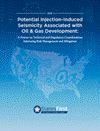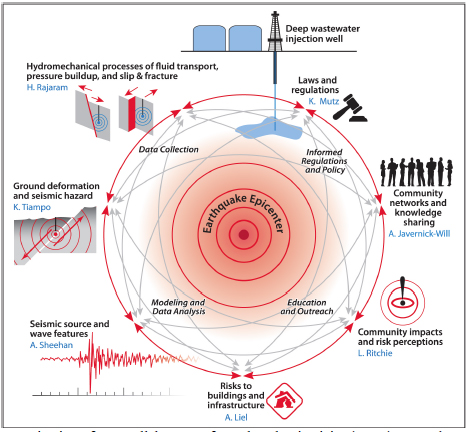
Wastewater Injection
A small fraction of wastewater disposal wells are being associated with large seismic events in Oklahoma and other states.
Deep-well injection has long been the environmentally preferred method for managing produced brine and other wastewater associated with oil and gas production. And the increase in horizontal drilling and hydraulic fracturing over the past decades has created a new demand for disposal wells that inject waste fluids into deep geological formations. The EPA estimates that about 10 barrels of wastewater are produced for every barrel of oil produced and that at least two billion gallons of brine are injected daily into disposal wells.
With increased injection comes an increasing concern in the United States that injection of these fluids may be responsible for increasing rates of seismic activity. The relationship between earthquake activity and the timing of injection, the amount and rate of waste fluid injected, and other factors are still uncertain and are current research topics. Despite increasing evidence linking some deep-well disposal activities to human-induced earthquakes, only a small fraction of the more than 30,000 U.S. wastewater disposal wells appears to be associated with damaging earthquakes.
In Colorado, examples of seismicity induced by fluid injection include:
- Liquid waste disposal at the Rocky Mountain Arsenal in the 1960s;
- Injection of fluids for enhanced oil recovery in the Rangely Colorado oil field in the 1960-1970s;
- Brine disposal to control Colorado River salinity near Paradox, Colorado in the 1990s; and
- Wastewater disposal wells in Greeley, Colorado in 2014.
Disposal of oil and gas wastewater by injection, in particular, has garnered a lot of attention in recent years due to the correlation between seismicity and injection in a number of states, including Oklahoma, Ohio, and Texas. Wastewater injection can trigger fault slip when fluids injected into the subsurface increase the pore pressure in the rock, effectively reducing the natural friction on a fault.
Other Oil and Gas Injection Activities
Class II UIC wells, regulated by EPA through 40 CFR § 146.21 – 146.25, include all oil and gas related injection wells, including wells for wastewater disposal, for hydraulic fracturing (“fracking”), and for enhanced oil and gas recovery.
While induced seismicity can occur in fracking operations, seismic events from these activities have been assumed to be rare. Some recent studies, however, have found hydraulic fracturing can play a role in producing seismic events. A recent publication in Seismological Research Letters, titled Hydraulic Fracturing and Seismicity in the Western Canada Sedimentary Basin (authored by Gail M. Atkinson et. al.), correlated induced seismicity with hydraulic fracturing in the development of oil and gas resources in the Western Canada Sedimentary Basin region. Honn Kao (research scientist at the Geological Survey of Canada) linked the nearby drilling to one of the biggest human-induced seismic events in Canada’s history in Rockies Today’s publication Alberta’s Seismic Shale Boom.
In response to earthquake activity in Oklahoma, the Oklahoma Corporation Commission (OCC) has tightened its protocol for fracking following an increase in the number of felt earthquakes that may be linked to well completions. In their news release "Moving Forward," Oil and Gas Conservation Division Director Tim Baker mentions that “the overall induced earthquake rate has decreased over the past year, but the number of felt earthquakes that may be linked to well completion activity, including hydraulic fracturing, in the new areas of oil and gas activity in Oklahoma has increased.” Baker mentions that the new protocol is the first step to mitigating the risk. Provisions include that all operators must have access to a seismic array to give real-time seismicity readings, some must take action after detecting 2.0 ML earthquakes, and they may have to pause work at the lowered threshold of 2.5 ML (was 3.0 ML), a level where one can feel the earth move, (OCC Protocol 2018)
Since about 2013, the Corporation Commission has issued about 30 orders affecting more than 700 disposal wells. After a magnitude 4.6 earthquake hit in early April, 2018, the Corporation Commission took steps even further by cutting back injection in the area’s disposal well by more than two-thirds, from 17,000 barrels a day to 5,000. According to an E&E News Energywire Earthquake report, “Oklahoma has become a hotbed of earthquakes linked to the oil and gas industry,” Mike Lee (E&E News Reporter).
Oil and gas operations also use enhanced oil recovery (EOR) and enhanced gas recovery (EGR) wells, to extract more oil and/or gas than ambient formation pressures would normally allow. Oil and gas operations can inject water or captured carbon dioxide into oil and gas fields to increase the pressure and enhance the speed and volume at which oil and gas can be extracted from a reservoir. To date, EOR or EGR activities have not been implicated in induced seismicity.
Investigating the Connections
 States – individually and in their associations -- are proactively discussing with their peers the possible association between earthquakes and injection of waste fluids. See, for example, a 2013 Induced Seismicity White Paper for an introduction to the issues. More recently, the Interstate Oil and Gas Compact Commission (IOGCC) and the Ground Water Protection Council (GWPC) created the Induced Seismicity by Injection Work Group (ISWG) through the State Oil and Gas Regulatory Exchange of the States First Initiative. The ISWG, prepared a 2015 report titled Potential Injection-Induced Seismicity Associated with Oil & Gas Development: A Primer on Technical and Regulatory Considerations Informing Risk Management and Mitigation. States – individually and in their associations -- are proactively discussing with their peers the possible association between earthquakes and injection of waste fluids. See, for example, a 2013 Induced Seismicity White Paper for an introduction to the issues. More recently, the Interstate Oil and Gas Compact Commission (IOGCC) and the Ground Water Protection Council (GWPC) created the Induced Seismicity by Injection Work Group (ISWG) through the State Oil and Gas Regulatory Exchange of the States First Initiative. The ISWG, prepared a 2015 report titled Potential Injection-Induced Seismicity Associated with Oil & Gas Development: A Primer on Technical and Regulatory Considerations Informing Risk Management and Mitigation.

A National Science Foundation project underway at the University of Colorado at Boulder, titled Hazards SEES: The Risk Landscape of Earthquakes Induced by Deep Wastewater Injection, is currently investigating the mechanisms by which earthquakes are induced by deep wastewater injection wells, the potential damages induced seismicity from deep wastewater injection wells can cause to structures (the built environment), and the social and economic impacts induced seismicity can impart on local areas.
For example, one project team, led by Kristy Tiampo, is investigating Surface Deformation and Subsurface Structure. Based on previous work, they note that new satellite-based geodetic techniques for measuring surface deformations have the potential to greatly improve our understanding of the fluid transport processes that lead to injection-induced seismicity. Satellite-based geodetic techniques can provide non-invasive, frequent, long-term, cost-effective monitoring of Earth’s surface and associated subsurface processes. The Tiampo team has previously used one technique, differential interferometric synthetic aperture radar (DInSAR), to detect subsurface changes in water volume by quantifying the associated ground surface height changes. The team is now working to (1) determine the subsurface migration pattern of injected fluids at their test sites, (2) identify if that migration is controlled by existing structures or fracture planes, (3) distinguish how the fluid migration is related spatially and temporally to the seismicity, and (4) establish the correlation between the critical parameters of the underlying medium to the occurrence of induced seismicity.
|

